Drishtikone Newsletter #357: Impending Destruction of Punjab and Sikhism
Between Conversions, Addiction, and Terrorism, we are looking at a convergence of forces within Punjab that can destroy it fully. Sikhism has lost its spiritual roots. We are staring at an impending disaster!


“In the depth of winter, I finally learned that within me there lay an invincible summer.” ― Albert Camus
Belief is a double-edged sword.
When it is subtle and "good-natured", it provides succor. An escape. From the realities of life.
Life, which sadly, even the best of spiritual masters have described as an ocean of suffering.
Only those suffer life who have no understanding of life itself. In its existential sense.
Life is an experience. In that experience is its fruition and purpose. There is no purpose served beyond that. Ask the trillions of humans who came on this planet and are part of the dust now. What grand purpose did they really serve?
Whatever anyone has created will not last beyond a certain time.
So why do anything?
For the joy of doing and the privilege of having an experience of being alive. This experience of living in the highest way possible on this planet does not come easy. We destroy many creatures and resources in our wake.
So, at least be aware of that privilege and the cost we put on everything else.
When Life is an extraction of some sort - happiness, comfort, and the rest of it - then there is a purpose. To maximize that perversion.
To be happy, we destroy, kill, change things, and own people and properties. We need crutches and props. Every prop needs to provide for us.
When we are in that state, then there is no scope for happiness.
For such people who look at external ways to fulfill themselves, life is an unsufferable tragedy.
Such people need religion to escape reality. Some stories, some fantasies, and some ideas of a God who loves.
When even that is taken away, then destruction is the only way out.
It is a slippery slope with only one result.
Punjab in India and Sikhism, which has become synonymous with that state, are facing the same challenge.
Teaching India a Lesson
In November 1971, Indira Gandhi went to the US. There, many believe she outwitted the Americans by not saying overtly that India would go to war even though she was ready.
The personal hatred of Nixon and Kissinger for Indira Gandhi and the Indians, in general, was brought out by the tapes that were declassified later.
Nixon called Indian women "the most unattractive women in the world" and Indians the "most sexless, nothing, these people" (worse than Black Americans, in his estimation). Indians, Nixon asserted to Kissinger in a meeting “To me, they turn me off. They are repulsive and it’s just easy to be tough with them.” It's not as if only Nixon was that way. Henry Kissinger said of Indians - “They are a scavenging people.” And then explaining the Indians' trait, he said "their great skill is to suck up to people in key positions."
Gary J. Bass, professor at Princeton, and the author of “The Blood Telegram: Nixon, Kissinger, and a Forgotten Genocide,” discusses how misogyny and racism became the bedrock of US policies against India.
For decades, Mr. Nixon and Mr. Kissinger have portrayed themselves as brilliant practitioners of realpolitik, running a foreign policy that dispassionately served the interests of the United States. But these declassified White House tapes confirm a starkly different picture: racism and misogyny at the highest levels, covered up for decades under ludicrous claims of national security. A fair historical assessment of Mr. Nixon and Mr. Kissinger must include the full truth, unbleeped. (Source: New York Times)
Sitting face to face with Richard Nixon, Indira Gandhi was firm while saying these words to him maintaining eye contact all the time.
India regards America as a friend. Not a boss. India is capable of writing its own destiny. We know and are aware of how to deal with each one according to circumstances.” (Source: Free Press Journal)
Richard Nixon's famous words were: “If India pokes its nose in Pakistan, US will not keep its trap shut. India will be taught a lesson.”
India will be taught a lesson.
Enamored by Yahya Khan who had facilitated the US-China meeting in 1970 (Source - National Security Archives), Nixon and Kissinger were instrumental in enabling the genocide of the Hindus
Instead, by using what Nixon and Kissinger called quiet diplomacy, the Administration gave a green light of sorts to the Pakistanis. In one instance, Nixon declared to a Pakistani delegation that, "Yahya is a good friend." Rather than express concern over the ongoing brutal military repression, Nixon explained that he "understands the anguish of the decisions which [Yahya] had to make." As a result of Yahya's importance to the China initiative and his friendship with Nixon and Kissinger, Nixon declares that the U.S. "would not do anything to complicate the situation for President Yahya or to embarrass him. (Document 9)." Much like the present situation post 9/11, Washington was hesitant to criticize Pakistan publicly out of fear that such a tactic might weaken the dictator's support for American interests (Source: National Security Archives)
That Pakistan was clearly targeting Hindus and unleashing a genocide was clear at the highest level.
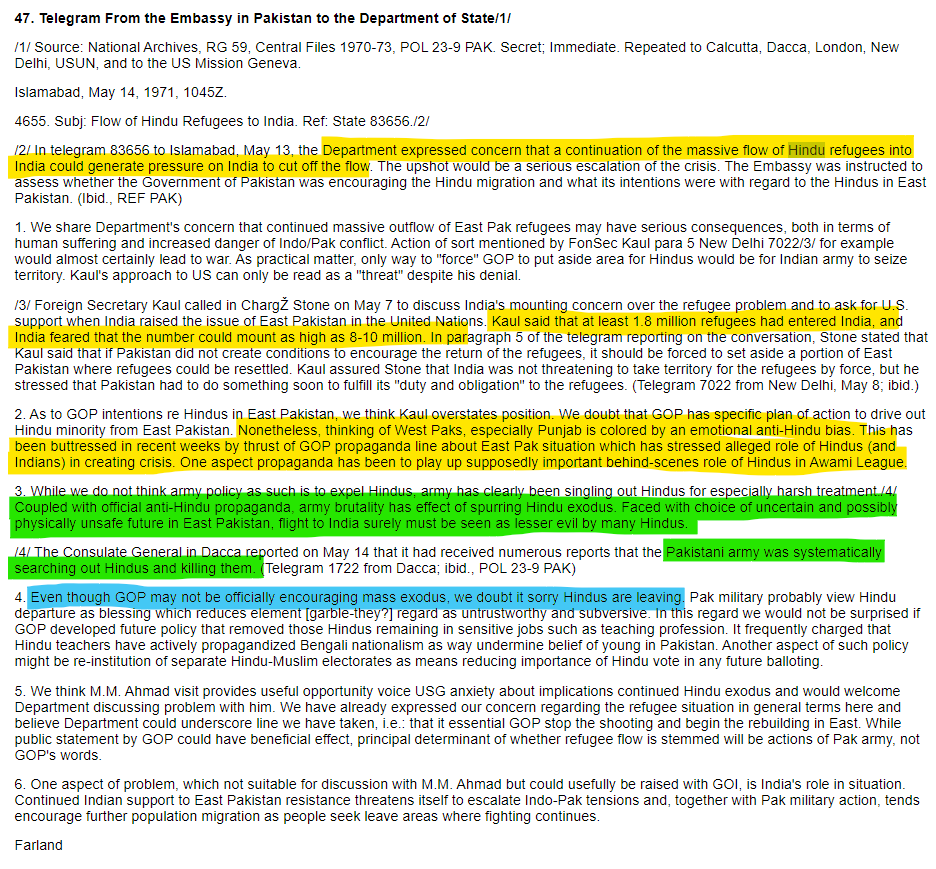
Yet the backing continued.
The trio of Richard Nixon, Henry Kissinger and Yahya Khan also collaborated on a Bangladesh type strategy against India in 1971.
The Richard Nixon administration in the US had initiated a "covert action plan" in collusion with Gen Yahya Khan's government in Pakistan in 1971 to encourage a separatist movement in Punjab, a former top officer of the Research and Analysis Wing (RAW) has said. "This plan envisaged the encouragement of a separatist movement among the Sikhs for an independent state to be called Khalistan. ...In 1971, one saw the beginning of a joint covert operation by the US intelligence community and Pakistan's ISI to create difficulties for India in Punjab," B Raman, who retired as Additional Secretary in the Cabinet Secretariat, says in his forthcoming book. (Source: Economic Times)
To enable this, the defunct "Sikh Home Rule" was rechristened to become the basis of the Khalistani movement. And Dr. Jagjit Singh Chauhan was hand-picked to run it.
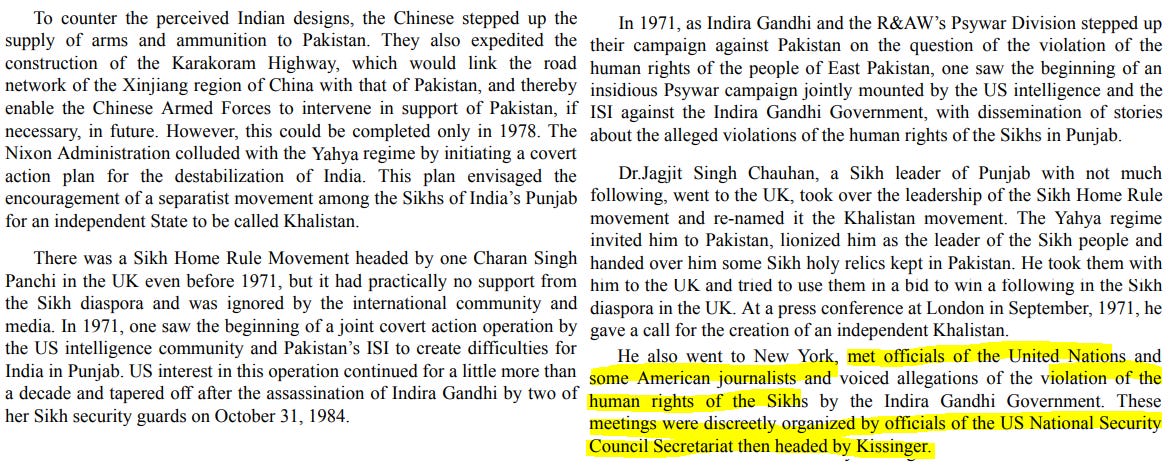
The urge to break India amongst the NATO intelligence network was very high. Khalistan was a powerful tool in their hands and they wanted to ensure that they used it to the hilt. And, this comes out most strongly in how Talwinder Singh Parmar was shielded by the West German intelligence along with their Canadian counterparts, even when the Indian authorities went to arrest him while he was en route to West Germany. Parmar was later involved in blowing up the Air India plane with over 300 passengers on board!
Giving an example of "non-cooperation", he refers to the authorities in the then West Germany. He says Talwinder Singh Parmar of Babbar Khalsa, a sacked sawmill worker in Vancouver in Canadawho was wanted in several cases in India like the Nirankari massacre and had been making "threatening" statements against Indira Gandhi, was arrested while travelling from Zurich to West Germany following an INTERPOL alert. The German authorities not only did not hand him over to a CBI team, which had rushed to Bonn to take him into custody, but sent him back to Vancouver. Two years later, Parmar played an active role in the conspiracy, which led to the blowing up of the Air India plane 'Kanishka' killing over 300 passengers, the retired R&AW official says adding, "the West German authorities cannot escape a major share of responsibility for this colossal tragedy." (Source: CIA, ISI encouraged Sikh terrorism: Ex-R&AW official)
As the decade of the 70s was coming to a close, the designs of Khalistanis were changing Punjab.
While Akalis were going down in their appeal, they found a lease of life by aligning with a firebrand named Jarnail Singh Bhindranwale.
They started their “Dharma Yudh” with Golden Temple as the base.
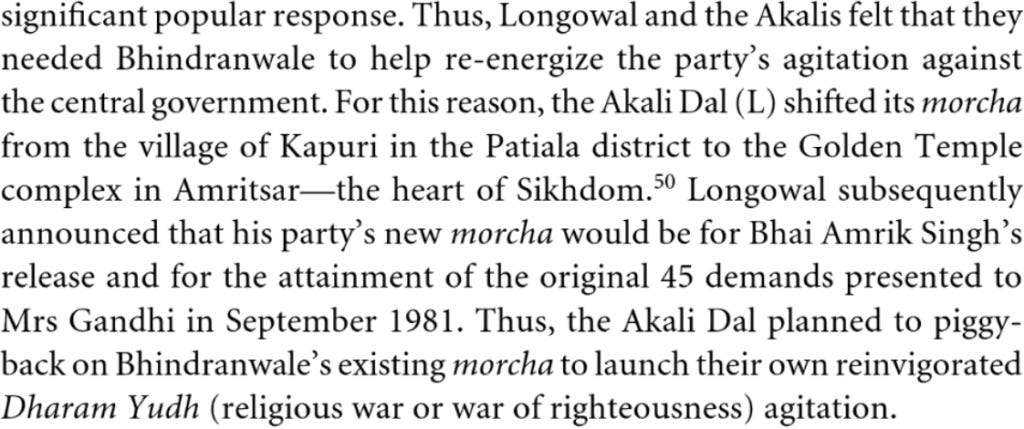
This Dharma Yudh was led by Akali Dal leader Prakash Singh Badal. Although the whole situation in Punjab had its differentiation into moderates and extremists and ultras, at some point, they were all working together.
The Dharam Yudha Morcha that was set with Akalis and Bhindranwale was funded and backed by Babbar Khalsa and Khalsa Diwan Society in Vancouver. (Source)
The Sikh political spectrum had all the elements - moderates, radicals and extremists. All working together and also competing.
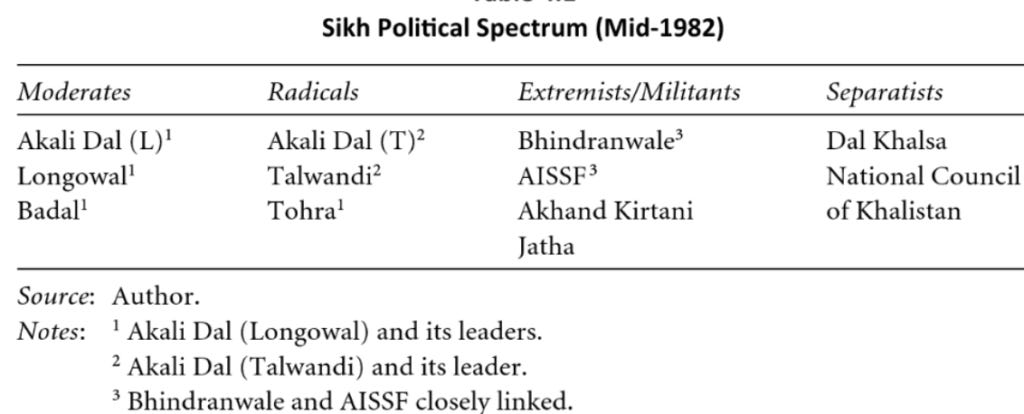
A pact was done between Longowal and Mrs. Indira Gandhi’s government, which was opposed by Haryana and Rajasthan. Angry about the “betrayal”, the Akalis decided to disrupt the Asian Games in November 1982 in New Delhi.
This was the beginning of the Khalistan mess in India. You can read these two newsletters for more details:
But why did the US establishment pivot its entire ploy on religion?
Religion as the Pivot: American Intelligence and its obsession with religion
To understand what has happened in Punjab and what is unfolding, it is incredibly important for us to understand the relationship that the CIA and the US "establishment" has with religion. How it is intertwined in its DNA and how those structures are used to not just view the world but even change it.
A simplified but bastardized interpretation of religions across the world, viewed through the lens of how the American intelligence understood the Catholic Church became the foundation of America's working domestically and globally.
In his landmark book "Errand into the Wilderness of Mirrors: Religion and the History of the CIA," Michael Graziano explains how American intelligence decodes the religions of the world and uses that knowledge for its functioning. A "Religion for Dummies - nah "Super-Dummies", if you will!
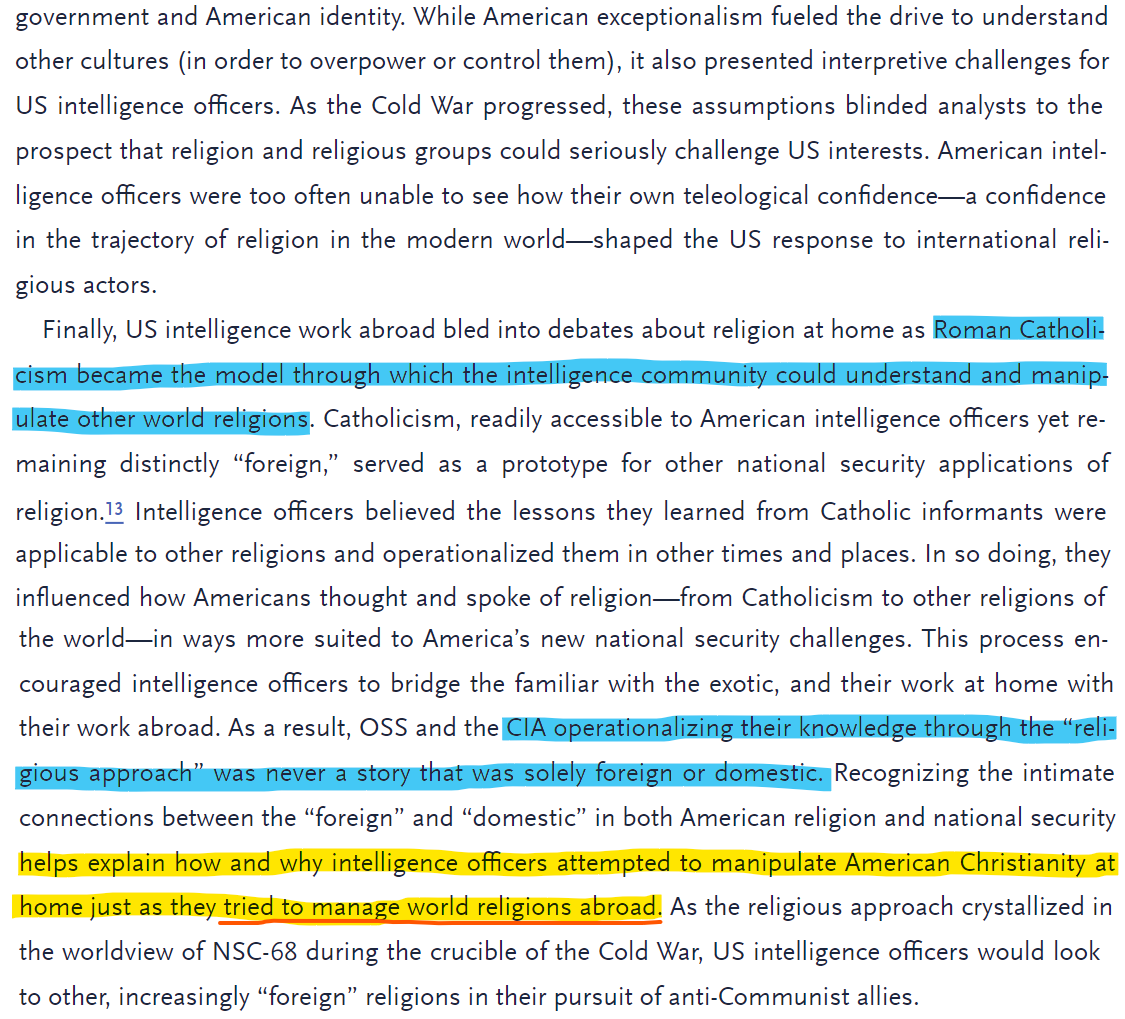
This attitude where Christian faith and the internal competitive games were the formative ways to look at the world, was intertwined with the supremacy establishing idea of "American Exceptionalism". The American establishment was there to establish a new world order the way it defined it.
In their contribution to Johnson and Weitzman’s edited volume, Lerone Martin and Kathryn Gin Lum argue that the FBI “arose as a major effort by the federal government to establish racial, ethnic, economic, and social order” (2017, 31) and tended to see non-White, non-Christian, or non-liberal religion as a threat to that order. Like the CIA’s relationship with the Catholic International Press described by Graziano, the FBI created “alliances with those who would defend the social order or who sought to curb the moral ills of modern life” (2017, 31). When we move beyond the experiences of these individuals to the effects of the violence they made possible, how can we understand “Americans’ tendency to think themselves expert on religion no matter their expertise” (182) as itself an expression of surveillance in the service of White Christian supremacy? The racial disparities in COVID deaths have demonstrated, yet again, how, like the anti-Judaism articulated at Christianity’s foundations in the second and fourth centuries, white supremacy has proved to be remarkably persistent in the US. (Source: Is CIA a Religious Institution? by Elayne Oliphant)
The world-view that the American intelligence and establishment used and nurtured was predicated on the inheritance of what the Colonial experiments in history, anthropology, and sociology had passed on.
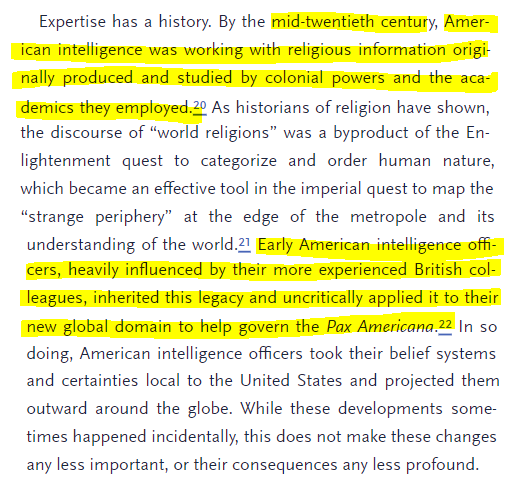
Why is this important?
Because most of the fissures and fault-lines that you see the "Breaking India forces" (using terminology from Rajiv Malhotra's book "Breaking India") using are eerily similar to the narratives of the British from the time they started the imperialistic rule in India.
Part of the imperial and colonial effort was to dismantle Indian society and its religion. Both were complex.
For example, Jean-Antoine Dubois, the French Catholic missionary who wrote about Hindus and their customs and tradition in his book "Hindu Manners, Customs and Ceremonies" shared his challenges. He hated the Brahmins in India and he expressed it clearly.
His problem with the Brahmins was that they were the chief impediments to the conversions of Hindus. The second point mentioned below comes from the justification of the first. Demonizing a group that you want to convert and hate in moral terms was the way Christians had followed against Pagans as well.
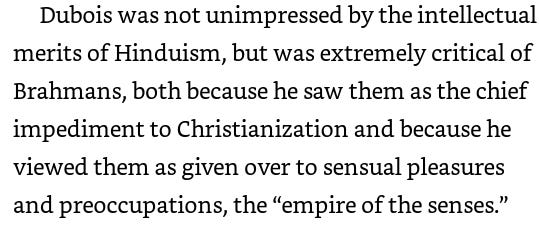
Isn't it interesting that the very things that were used by the British colonialists to view and target India and the Hindus find echoes in the very narratives that are used in India even today to accentuate the fault lines:
Hatred for Brahmins
Using the Caste System as a short-hand for Hindus
The recent strategies against India have focused along those lines.
With this understanding let us see what is unfolding with respect to Punjab.
Mass conversions in Punjab
“Baari Baari Barsi Khattan Gaya Si, Khat Ke leyandiyaan pattiyan, Ni Giddha taan sajda je nacchan Yeshu diyan betiyaan” (I went to away for 12 years, and returned having bought some leaves, The gidda looks beautiful, when the daughters of Jesus dance) (Source)
That is the new flavor of the famous Punjabi tappe being played in India's Punjab now.
Christianity through mass conversions is increasing in Punjab at a breakneck speed. Unfortunately, the census numbers do not show that.
Bishops and pastors of Pentecostal and para church organisations of Punjab said here on Saturday that the census, which is conducted by the government after a decade, did not tell the actual number of the Christians residing in Punjab. While interacting with mediapersons on the sidelines of the state-level assembly of the Christian leaders, organised at Virsa Vihar here, a Christian leader Imanul Rehmat Masih said, “In reality, our population is 7 to 10% in the state, but the latest census shows us less than 1% under a deep-rooted conspiracy against the fast emerging religion.” (Source: Hindustan Times)
This dichotomy and the truth in the anecdotal numbers thrown by Christian leaders in Punjab can be further seen in how fast the Churches are springing up in the state.
Kamal Bakshi is the state president of the United Christian Front, a group that has committees in 8,000 of Punjab’s 12,000 villages. According to him, there are 600-700 churches in Amritsar and Gurdaspur districts that belong to four Christian denominations. He says 60-70 per cent of these have sprung up in the past five years. The Christian faith has co-opted many of the cultural markers of Punjab, from turbans to tappe. On YouTube, one can find Christian giddas (a folk dance), tappe (a musical form) and boliyan (sung couplets), and songs in praise of Jesus in Punjabi. The visuals show men and women singing these songs in a rural Punjabi setup. (Source: ThePrint)
This group - United Christian Front - is an important one to remember. It is politically quite active as it is in planting churches across the country.
Kanwal Bakshi himself is a Congress Leader.
Kanwal Bakshi, a Congress leader belonging to the Christian community, on Thursday questioned as why he had been left out of the new list of the Punjab Congress Committee office-bearers. A former member of the Punjab State Subordinate Service Selection Board (PSSSB), Bakshi said he held various organisational posts in the state Congress. He said he was the president of the United Christian Front, Punjab, and had organised state-level Christian gatherings for former Punjab chief minister Capt Amarinder Singh and PPCC president Partap Singh Bajwa to win support of the community for the party. (Source: Hindustan Times)
The intertwining of the church planting, conversions, and political agendas has done what such things do best - create vote banks.
"In Punjab, there are around 900,000 Christian voters and the largest chunk, 17 per cent, reside in Gurdaspur district. Here their number is over 150,000. After Gurdaspur, maximum Christian voters are in Amritsar, Ferozepur and Ludhiana districts," Kanwal Bakshi, state president of Punjab's United Christian Front (UCF), told IANS. "This time we want a change in Punjab and Christians are not going to vote for the BJP or the Akali Dal. We are all fed up of their anti-Christian policies and moreover their leaders are never accessible to us," Bakshi declared when asked about the way the community was inclined to vote. (Source: India Today)
The United Christian Front and Congress leader said explicitly that they will not vote for BJP or Akali Dal.
Even these numbers - 17% in the Gurdaspur district - may be conservative. Father Michael Anikuzhikattil, the parish priest of Gurdaspur, put the number at 25%! A fourth of the Gurdaspur district in 2010 had become Christian!
Father Michael Anikuzhikattil, parish priest of Gurdaspur, told UCA News that a general strike was in force in Gurdaspur district on Feb. 21. According to him, “the objectionable posters” hurt Christians, who form 25 percent of the district’s population. (Source: Archive of Union of Catholic Asian News / February 2010)
So who all are converting to Christianity and why? The Secular India media has its old bogeyman - the caste.
Tired of centuries of casteism and systemic oppression, many Dalits, belonging to the Mazhabi Sikh and Valmiki Hindu communities living in Punjab’s border belt, have started looking to Christianity in the hope of a dignified life and access to better education. (Source: ThePrint)
That is a very lazy and Dubois-type way of looking at the issue at hand.
Here is a Jatt Sikh donning the Sikh turban sharing his belief in his Lord Jesus.
The clothing is part of the whole scenario. Former Sikhs, with turbans, have been converting and keeping their looks intact.
Some converts from Sikhism don’t discard their turbans. “Clothes don’t determine anyone’s religion. I have been wearing a turban since I was a young boy. Why should I take it off now that I am a Christian? It’s a part of my identity,” a devotee who does not wish to be named tells ThePrint. (Source: ThePrint)
So what are the incentives for converting to Christianity?
The promise of goodies - like Visas. To Canada, England, and the US.
Healing the suffering of the poor and the illiterate
Free facilities like hospitals, schools, and financial assistance
One of the ways by which they entice the innocent yet alienated people is by promising them a visa to Canada, England or the USA upon conversion. They entrap illiterate and disabled people to get baptised by convincing them that God would take their pains and sufferings away. The other way is by giving them incentives such as free medical aid in hospitals run by the Christian Missions, free education, healing chronic illness and other financial benefits. (Source: News18)
Because the "miracles" argument is central to Christianity, such bizarre scenes can be witnessed across the Punjab landscape these days in what are known as the "Crusades".
0:00
COVID created a great conversion opportunity for the miracles-obsessed Christian conversion machinery. For example, this Sikh man, who still calls himself Sikh but totally believes in Christianity, shares how a "pastor saved him during COVID".
Basis such large-scale conversion industry that has the backing and financing from outside churches, the "Crusades" are now attracting large crowds. Miles long.
As Ankur Narula shared this tweet in 2018 about the 1/2 kilometer-long crusade.
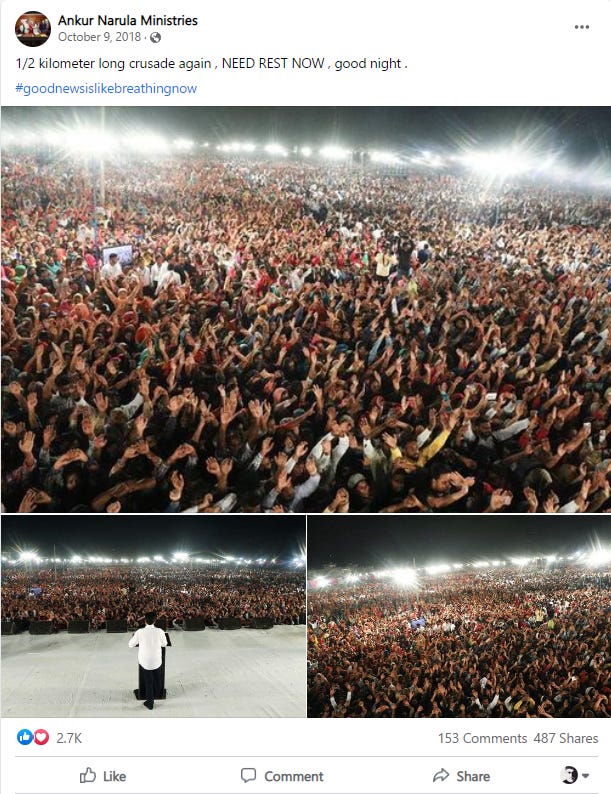
Now he is talking about a 5-km-long crusade (Source).
The rampant conversions and church planting as an industry has a parallel. In Multi-level marketing.
It is an industry that self-sustains itself after a point.
Church Planting and lessons from Multi-level Marketing Techniques
Multi-level Marketing techniques have been very useful in creating a "business model" for planting churches across the globe.
Evangelism looks at growing all the time. Towards that, they create methods and models to push the conversions.
Evangelism is not enough…. especially in a nation where ‘accepting Jesus’ may be no different than accepting 33 million other gods. The Lord Himself said, “Go, make disciples of the nations”. In 1987, a movement was begun in India to not only evangelize, but to make disciples through personal leadership training and the planting of churches. Since that time, HBI has planted over 11,000 churches in 23 states, and the number grows daily. Through a systematic combination of classroom training and field experience, people are trained over seven years; first as evangelists, then disciple-makers, then as church planters. (Source: HBI Church Planting)
Here is one Church Planting model that shares the broad framework.
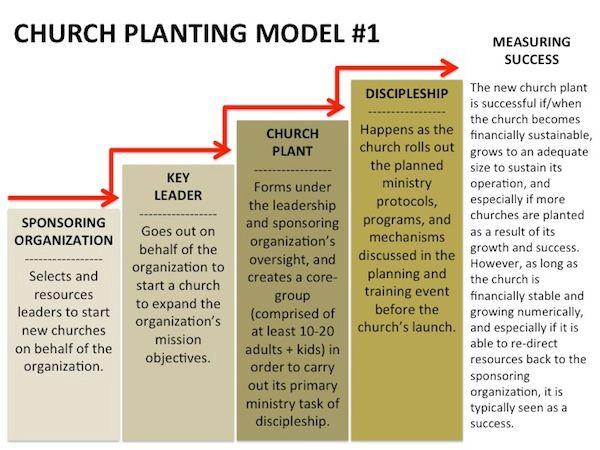
Check closely and you can notice that it resembles the MLM industry model. In fact, this interesting reflection from Scott Clark, a minister in the United Reformed Churches in North America since 1998 shares how the MLM model was inspired by the evangelical model developed by Presbyterian minister named Charles Grandison Finney.
I broke out of my pragmatic, MLM, EMM bubble by reading John Stott’s Basic Christianity. Then I read J. I. Packer’s Evangelism and the Sovereignty of God and then Packer’s Knowing God. I learned that there was an alternative to the entrepreneurial, pragmatic model I had learned. It was a more churchly way to think about Christian discipleship. Decades later I know that the MLM approach to discipleship was taught was rooted not in historic Christianity and not in Scripture. It was a miniaturized version of an approach to evangelism and “church growth” developed by a renegade Presbyterian minister named Charles Grandison Finney. He had developed, in effect, an evangelism machine. The evangelist put in the raw material (potential Christians) into the machine, turned the crank (i.e., used the correct procedure) and out would come the desired product: a convert. Rinse and repeat. (Source: "From MLM To The Freedom Of The Christian")
Bruce Gerencser lives in rural Northwest Ohio. He has pastored evangelical churches in Ohio, Texas, and Michigan for 25 years. Then he left Christianity. He hit upon the similarity as well.
Several days ago, I wrote a post titled J.A. Medders Asks: What Do You Think Jesus is Doing Right Now?. As I read the comments on this post, I had thoughts about how similar multi-level marketing (MLM) programs are to the various methods and programs Evangelicals use to evangelize people they deem unsaved/lost/unregenerate and headed for hell. (Source)
Another one “Captain Cassidy” writes in Patheos about how the MLM model is what evangelicals use for Church planting.
Lately I’ve been reminded anew about just how big the overlap is between MLMs and fundagelical-style Christianity. Today I’ll show you some of those similarities–and we’ll see how easy it is for someone to escape one false and harmful group only to land smack-dab in the middle of one that’s just as bad or worse, all because of indoctrination points shared by both groups. (Source)
And then Cassidy shares the similarities.
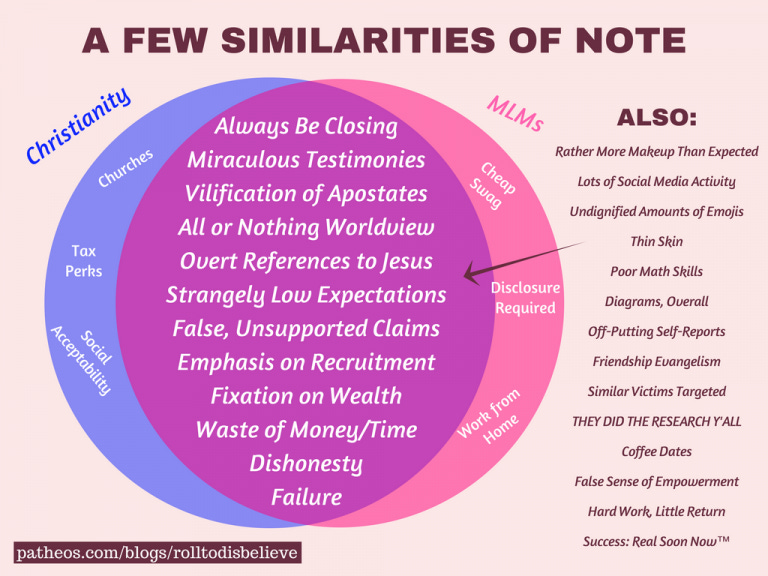
So when you see the numbers growing exponentially, and are not able to fully understand how this movement is spreading, the financial sustainable model that MLM techniques bring to the mix may give some insight.
Ok, now we know that in Punjab, conversions are rampant.
So what?
Religious Conversions are not a "religion issue" but a "National Security issue"
Converting people in far-off lands with deep funding cannot be just an altruistic endeavor. It has to be more than that.
It is.
We have seen how Michael Graziano has detailed the close relationship between the CIA (and by proxy the Western intelligence agencies) and Religion in his book Errand into the Wilderness of Mirrors: Religion and the History of the CIA". Religion is a tool that is used for shaping, gaming, breaking, and destroying the societies and groups that do not lend themselves to American Exceptionalism. If your group is not working per the world order that the American establishment wants to establish, then there are ramifications.
Religion is one tool and weapon that can be used.
To fully understand, let us go back to 2012. That was when India wanted to set up a nuclear station at Kudankalam in Tamil Nadu. The nuclear plant became the target of protests by the Church and related activists.
"The Kudankulam nuclear station (Tamil Nadu) is a question of life and death for the entire population," Mgr Yvon Ambroise, bishop of Tuticurin, said. Critical of the government's silence with regards to the Kudankulam nuclear plant, he warns that the latter might damage the environment and man. In an interview with AsiaNews, the prelate said that the Church is in leading the defence of the rights of the local population irrespective of religion, ethnicity and social status. (Source: "Tuticurin bishop calls for a stop to nuclear plant that endangers people" / Asia News of the Pontifical Institute for Foreign Missions missionaries)
One of the main protestors was the People’s Movement Against Nuclear Energy (PMANE) chief S.P. Udayakumar. He was working closely with foreign nationals and groups for funding.
PMANE convenor, Dr S.P. Udayakumar, has accepted that he has had close connections for the past four years with German national Sonnteg Reiner Hermann, arrested from a Nagercoil lodge and deported to his home country on charges of raising funds for the anti-KKNPP movement. Contrary to his statement on Monday that he did not know much about the German arrested from a Nagercoil lodge, he told DC on Tuesday that last year, Mr Hermaan participated in the annual day function of his SAACER matriculation school founded by him and his wife Meera. (Source: Asian Age)
Later on, in 2014, Udaykumar and his suspect funding sources were called out.

Even though the Churches in Kerala kept describing the whole movement as a "people's movement", it clearly had the hallmark of a religious institution intervening in a matter of national security.
The question was - at whose behest?
And, that was not the only instance. The same model has been replicated against the Adani Port in Vizhinjam.
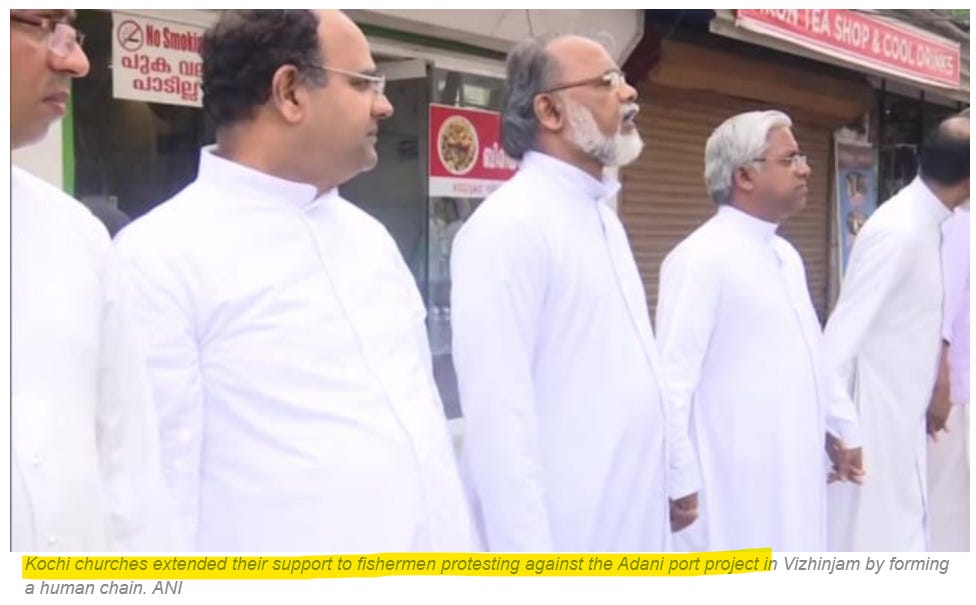
The similarities and the modus operandi are hard to dismiss.
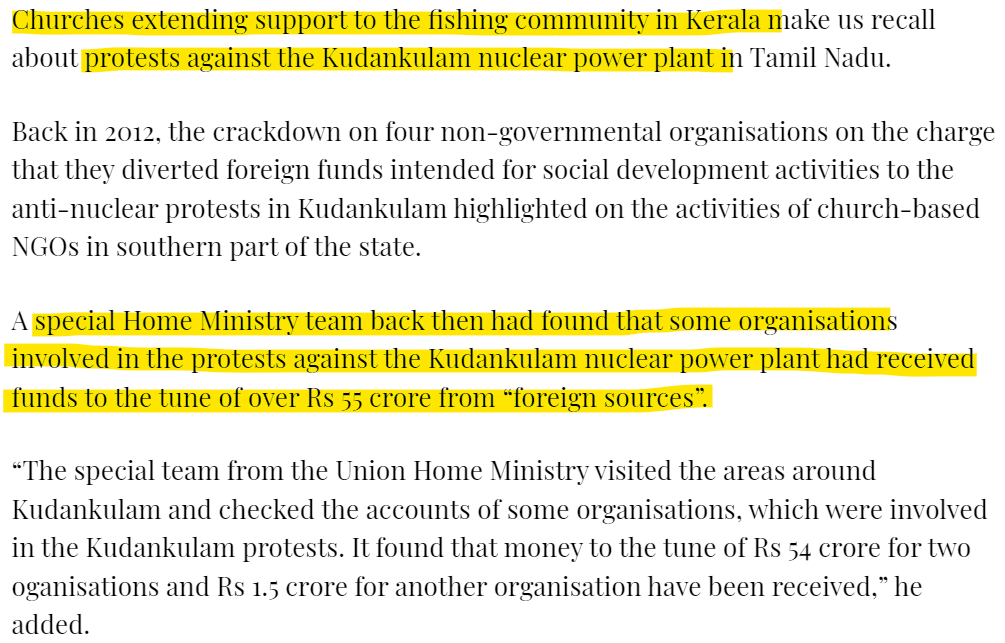
So, when conversions happen in such large numbers, be very clear about what is to follow next.
The funders will come looking for their pound of flesh.
Now back to Punjab.
Spiritual Vacuum: What has caused such a breakdown in Punjab?
Yes, conversions have happened and are happening in India. But why are they happening on such a large scale in Punjab?
Puneet Sahani shares something very interesting. Sikh Gurudwara Prabandhak Committee (SGPC) the apex Sikh body these days was always aligned with the British before independence. What started off as a body to simply manage the Gurudwaras ended up deciding the politics of Punjab post-independence. And SGPC and the ecosystem have created a spiritual vacuum in Punjab. This vacuum is now resulting in mass conversions in Punjab, but not Haryana, which also has a similar demographic.
The spiritual vacuum that the breakdown of Sikhism has created is not just visible in terms of how people in Punjab are converting over to the ideologies of the different Churches peddling miracles in the towns and villages, but this is manifesting in another ill.
Rampant Addiction in Punjab
When there is no solace from the religious succor, and the situation is still tough, then the populations look for an escape.
Miracles are one type of escape.
Addiction is another.
The estimates of how this second ill is destroying Punjab are stark!
Per one estimate 75% of Punjab's youth is now addicted to drugs. Every third family has one addict!
Many still feel that even these figures may be conservative.
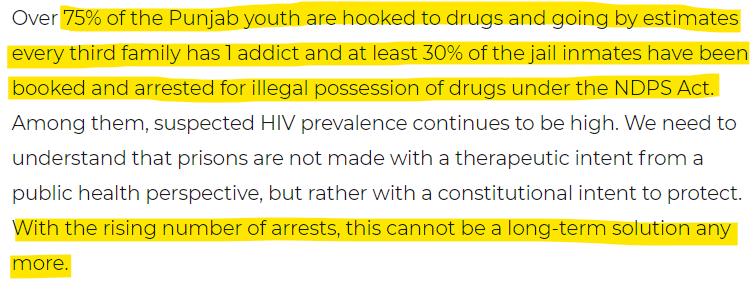
Per another estimate, 16% of Punjab is now addicted.
Drug use in Punjab has been estimated through surveys of selected sample groups, as scientific studies tend to be. There has never been a state-wide census-type survey. “Over 16% [of Punjab’s] population is addicted to hard drugs,” said this affidavit submitted by Harjit Singh, secretary of the state’s Department of Social Security and Women and Child Development, citing a departmental survey (a few lines from that affidavit have also been cited in a Punjab state document uploaded here), in reply to a petition filed by some drug rehabilitation centres before the Punjab and Haryana High Court in May 2009. (Source: Scroll)
Whatever the numbers are, the situation is very dangerous.
The problem of addiction has now hit women in a big way. In some cases, even more than men.
For example, this lady Harjot Kaur had become so hopelessly addicted along with her husband, that at one point she did not even realize that her husband went missing. They mortgaged their home to finance their addiction!
Harjot Kaur has no idea whether her husband is dead or alive. “Ki pata poora ho gaya hova (he might have died),” says the 30-year-old, disdain dripping from her words. The couple had a bitter fight one day and he broke her arm. “I was writhing in pain. He gave me chitta (heroin) saying it was a pain reliever. An illiterate, I believed him,” she says. He was a drug addict. She too was soon hooked. “Initially we used to take pure heroin. Then there was no money to buy it. Then we started injecting cheap white powder mixed with water, at least five times a day. We mortgaged our home to buy drugs. It cost us everything,” Harjot adds. The husband then took to petty thefts and snatchings to fund his addiction. “He spent three years in jail,” she says. So intense was her addiction that she doesn’t even remember when exactly her husband went missing and never returned home. (Source: "Punjab: The invisible drug addicts" Indian Express)
Here is a video of a girl whose parents had chained her to save her from addiction. She shared how things are really bad in Punjab right now.
0:00
Social media these days is full of videos of how girls are being impacted by addictions. Here is a quick compilation.
0:00
The fact that drugs are increasing in Punjab is not a coincidence. The push by Pakistani ISI in recent years has been to kick-start Khalistan terrorism to create violence in Punjab.
Narcoterrorism: Drugs and Khalistan terrorism
Towards that, they have combined the Narcotics trade with Terrorism. Narco-Terrorism.
Delhi Police, NIA and other central agencies reveal how the Pakistani government and its intelligence agency ISI has been involved in the conspiracy to disturb peace in Punjab. Details from the agencies revealed that the Pakistani government has been conspiring for the last six years and misleading the youths of Punjab. In order to destabilise poll-bound Punjab, the Pakistani government and the ISI set up a K-2 (Kashmir-Khalistan) desk. (Source: India Today)
The terror modules that have been set up by ISI are pushed to sustain themselves by pushing drugs for creating their financing.
According to the chargesheet, Pakistani intelligence agency ISI, along with Khalistani terrorists Harmeet Singh, alias Happy PHD, and Lakhbir Singh Rode, conducted targeted killings of RSS and Hindu leaders from 2016 to 2017. They aimed to fuel the ‘Khalistani Movement’ in Punjab through these activities. These targeted killings alerted the central agencies who started investigating Pakistan’s role in the crimes. The ISI also intended to carry out similar activities in Delhi. The ISI set up the K-2 desk and appointed its top officers to carry out terror activities in Punjab. These officers, on the directions of Lakhbir Singh Rode, used to supply funds to gangsters who fled to Gulf countries from Punjab. Sitting in Rawalpindi, Pakistan, Hizbul Mujahideen terrorists Abdul Majid and Sadaqat used to send drugs to the over ground workers (OGW) of the outfit’s Kashmir unit. The OGWs would then take the drugs to gangsters in Punjab for distribution in the state. The funds from the drug smuggling would be used for terror activities, acquiring weapons from Pakistan, and sustaining the gangsters. Balwinder Singh Sandhu was killed as part of this narco terror operation initiated by the K-2 desk. (Source: India Today)
We are looking at the convergence of a lot of forces. Let us understand.
Destruction of Punjab
Punjab has been the hub for agriculture, sports, industry, and military forces in India. A large part of Punjab's DNA was created by the predominance of Sikhism and a syncretic culture where Hinduism and its offshoot Sikhism worked together all these years.
During partition as well, the Muslim League National Guards, the militant arm of the Muslim League targeted Hindus and Sikhs together. They were seen as the "other" and "together".
But things started changing and the bond was ruptured.
Sikhism was being altered and changed with the help of the British. Two protagonists of this change were Max Arthur MacAuliffe and Bhai Vir Singh. These two set the foundation of religion with the help of their writings, which took the Sikh spiritual framework away from Hindu roots. They were instrumental in Dehinduizing Sikhism.
Please listen to Puneet Sahani on this topic.
As the Khalistani movement was created and became the spearhead of the division and separation from the Hindu roots of Sikhism, the legacy of the Gurus also lost its spiritual basis.
It was now becoming a replica of a Talibanized doctrinal ideology. There was no scope for any difference or liberty anymore. One body and a certain ideological way would dictate things.
In that scheme, the poor and marginalized Sikhs lost the most. Also, when the spiritual basis was being destroyed within Sikhism, the stoic ways of Sikh Gurus were also lost. What was left was a population looking for help and succor.
Ways of the Gurus did not provide that because they were creating a powerful group of self-sustaining, independent, and self-reliant seekers.
What started off as a trickle after the failures of the Green revolution multiplied in the aftermath of the 1980s Khalistan terrorism.
What is left in Punjab in the name of Sikhism is a pale shadow of the formidable spiritual heritage that was created by the ten Gurus.
Between Conversions, Addiction, and Terrorism, we are looking at a convergence of forces within Punjab that can destroy it fully.
More importantly, the days of Sikhism are now numbered.
Video Corner: The Bouncer that Changed it all
Some revolutions are a product of extraordinary events that happen unexpectedly.
The ascendancy of the West Indies team in Cricket in the 1970s is one of those things. One bouncer that was targeted at Vivian Richards, the West Indian great, changed things for that team. In response, they created what was the most feared bowling attack in the world. The four pacer attack.
This is the story of how it happened.
If you like our content and value the work that we are doing, please do consider contributing to our expenses. CHOOSE THE USD EQUIVALENT AMOUNT you are comfortable with.
If you like this post - please share it with someone who will appreciate the information shared in this edition.
Today’s ONLINE PAPER: Check out today’s “The Drishtikone Daily” edition. - THE DRISHTIKONE DAILY



